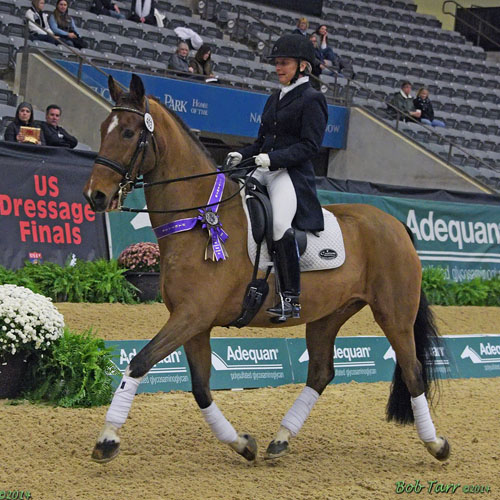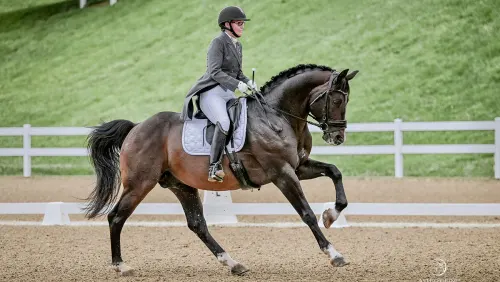While Hackneys are normally known for their high-stepping leg action and talent for carriage driving, Baryshnikov is proving the breed can excel at the top levels of dressage.
The Hackney horse and his rider, Lisa Pierson, qualified to compete at the U.S. Dressage Finals in Lexington, Ky., at Intermediaire I on a wild card earned at the Region 8 Championships (N.Y.) and they came home with a seventh place finish (67.01%) in the open Intermediaire I championship, as well as a win (70.52%) and a second place (63.77%) ribbon in two other Intermediaire I classes.
Pierson has been riding and showing “Barry” on and off for the last four years for owner Leeda Fletcher.
The 14-year-old U.S.-bred gelding (Forewood Commander—Woodhurst Ballerina, Hurstwood Solarity) was bred to be a driving horse but was bought by his former rider, Kelly O’Shea Duncan, as a dressage prospect untrained and unbroken, when his markings didn’t match the rest of the four-in-hand team he was meant to compete with.
She took him through Intermediaire I before Fletcher bought him in 2011.
ADVERTISEMENT
“He’s very hot but he’s really like a Border Collie,” said Pierson. “He really, really wants to do a good job.”
Pierson had no reservations taking on an unusual breed to train and she said the main thing she works on is getting Barry to stretch into the contact. When he does that, his step gets bigger and more swinging, instead of up and down.
“It’s hard to keep his front end out and loose instead of coming up,” she said. “His knees like to come up. It’s a fun challenge as a rider. He’s extremely animated.
“He’s tighter in his topline,” she continued. “It’s harder to get him to use and swing his back, but he does. That’s been the main thing. He’s extremely smart and extremely sharp in wanting to learn and do things, but the suppleness is probably the hardest part. [We do] lots of stretching and lateral work. Once he learns something, you don’t have to drill anything. I hack him out a lot—he’s very alert to surrounding stuff.”
Pierson, a professional based at CB Walker Stables in Brewster, N.Y., was thrilled to get the invite to the championships and made the 14-hour trip three days before she was due to show.
ADVERTISEMENT
She was pleased with her championship test on Friday, but then the weather turned on Saturday and Barry got a little tight. He rebounded on Sunday to win his class.
“He’s a bigger-boned Hackney than most,” she said. “Some people notice he’s a different breed and some people are surprised. For me, it depends on how he’s riding that day—if he’s nervous and a little tight, he does look much more like his breed, but if he’s loose he really can swing his back.”
She added that while Barry can get tight, he’s always trying for her.
“His half-passes are awesome,” said Pierson, 49. “They’re just beautiful because of his front end—very flamboyant. His tempi changes, when he’s with me, he does exactly what I say. There was a point in the championship class where I patted him with my right outside rein at the end and when I shifted my weight a little bit he did an extra change. That was completely my fault, but he’s just cued in that much. He’s either really cued in to me or on rare occasions, cued into things going on outside the ring. He’s extremely intense, so if he’s distracted it’s pretty distracted.”
Pierson is aiming Barry for Grand Prix this winter in Florida and said he’s already schooling most of the movements at home.
“His passage is great and he’s got his one-tempis pretty well,” she said. “It’s just trying to keep him from getting too excited in those. The hardest thing is the piaffe because his front end is quite active and getting his hind end to try to match that is the primary difficulty.”















